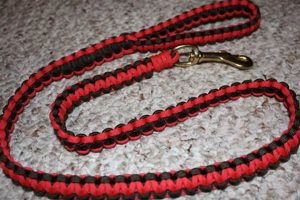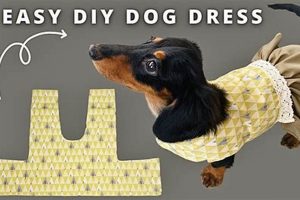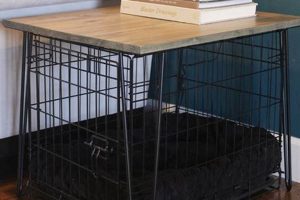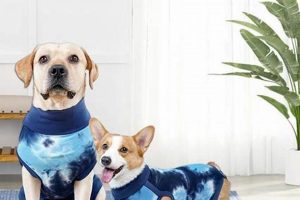Creating personalized attire for canines involves the crafting of unique garments and accessories by individuals, often utilizing readily available materials and basic crafting techniques. This process allows pet owners to design outfits tailored to their dog’s specific size, shape, and personality. Examples include transforming old t-shirts into miniature superhero capes or repurposing felt scraps into festive hats.
The practice offers several advantages. It provides a cost-effective alternative to purchasing pre-made items, fosters creativity and a stronger bond between owner and pet, and enables the creation of outfits that are both functional and expressive. Historically, dressing animals, particularly dogs, has been linked to practical purposes like protection from the elements. However, contemporary custom creation largely focuses on aesthetics and participation in events like Halloween or costume contests.
Subsequent sections will delve into various design ideas, material selection considerations, safety guidelines, and step-by-step tutorials for constructing different types of wearable items for canine companions. These guides will address a range of skill levels, ensuring accessibility for both novice and experienced crafters.
Creating Fido’s Finest
The following guidance addresses crucial aspects for individuals undertaking the creation of unique canine apparel, ensuring both aesthetic appeal and canine comfort and safety.
Tip 1: Prioritize Canine Comfort: Select fabrics that are soft, breathable, and non-irritating. Avoid materials that may cause overheating or restrict movement. Consider natural fibers like cotton or fleece as primary choices.
Tip 2: Accurate Measurements are Paramount: Before commencing any construction, meticulously measure the dog’s girth, neck circumference, and back length. These measurements form the foundation for a well-fitting garment. Add seam allowances and adjust patterns accordingly.
Tip 3: Safety First: Eliminate potentially hazardous elements. Avoid small, detachable embellishments that could pose a choking hazard. Ensure closures, such as Velcro or snaps, are securely fastened and positioned to prevent entanglement.
Tip 4: Simplicity in Design: Initially, opt for straightforward designs. Simple patterns reduce the likelihood of errors and allow for easier fitting adjustments. As skills develop, more intricate designs can be attempted.
Tip 5: Consider Functionality: Design with the dog’s activities in mind. If the dog frequently walks outdoors, incorporate reflective elements for enhanced visibility. Ensure the garment does not impede natural behaviors like urination or defecation.
Tip 6: Gradual Introduction: Introduce the finished product to the dog gradually. Allow the dog to acclimate to the sensation of wearing the garment in a controlled environment before extended wear.
Tip 7: Regular Inspection and Maintenance: Routinely inspect the attire for signs of wear and tear. Promptly repair any damage to prevent further deterioration and potential hazards.
Adherence to these principles will contribute to the creation of items that are not only visually appealing but also safe, comfortable, and functional for the canine participant.
The subsequent section will address specific project ideas, catering to various skill levels and offering detailed instructions for successful implementation.
1. Fabric Selection
Fabric selection critically influences the outcome of any canine apparel creation project. The chosen material directly affects the garment’s comfort, durability, and overall aesthetic appeal. Improper material selection can lead to skin irritation, overheating, or restricted movement, thereby negating the purpose of the created item. For instance, using a stiff, non-breathable synthetic fabric for a summer outfit will likely result in discomfort and potential overheating for the dog.
Considerations should extend beyond mere aesthetics. The material’s weight, texture, and washability play significant roles. A lightweight, washable fabric like cotton or fleece is generally preferred for everyday wear. For specialized costumes designed for outdoor use, a water-resistant and durable material might be necessary. Furthermore, the fabric’s colorfastness should be evaluated to prevent dye transfer onto the dog’s fur. Selecting a fabric inappropriate for machine washing can lead to premature deterioration and require time-consuming hand washing.
Ultimately, the success of apparel making hinges on selecting materials congruent with the dog’s needs and the intended purpose of the garment. Prioritizing comfort, safety, and practicality over purely aesthetic considerations ensures a positive outcome. Neglecting the importance of material selection results in uncomfortable and potentially harmful apparel. It underscores the importance of thorough material assessment and thoughtful decision-making.
2. Accurate Measurement
Accurate measurement constitutes a foundational element in the successful creation of wearable items for canines. Inadequate or imprecise measurements lead to ill-fitting garments, which can cause discomfort, restrict movement, and potentially pose safety hazards. The direct effect of inaccurate measurement manifests in several forms, including costumes that are too tight, impeding the dog’s ability to breathe or move freely, or costumes that are too loose, increasing the risk of entanglement or tripping. A real-life example involves attempting to craft a superhero cape without correctly measuring the dog’s neck circumference; the resulting cape might either choke the animal or slip off entirely, rendering the effort futile. The practical significance lies in avoiding these issues, ensuring a comfortable and safe experience for the canine.
The practical application of accurate measurement extends beyond simply obtaining numbers. It involves understanding canine anatomy and adjusting measurements accordingly. For example, considering the dog’s chest depth and width allows for incorporating appropriate ease in the garment, preventing constriction. Similarly, accounting for the dog’s leg length and stride influences the placement of leg openings in a coat or overalls, ensuring unrestricted movement. The measurements also inform the pattern drafting process, either from scratch or when adapting existing patterns. Failure to adequately consider these factors results in a product that may visually resemble a garment but functionally fails to meet the dog’s needs.
In conclusion, the meticulous acquisition and application of precise measurements are not merely procedural steps but integral components of responsible crafting. Overlooking this aspect can compromise the safety and comfort of the animal. While challenges may arise in measuring a moving or uncooperative dog, employing techniques such as using treats as a distraction and having an assistant to aid in measurement can improve accuracy. This practice directly affects the overall quality and success of the project. The accuracy is linked to the overall theme of creating functional, safe, and aesthetically pleasing for canine companions.
3. Safety Fasteners
The selection and implementation of appropriate safety fasteners are paramount in the domain of handcrafted canine attire. An inadequate or poorly chosen fastener can directly lead to hazards, negating the intended benefits of the garment. The cause-and-effect relationship is straightforward: if a fastener fails or is improperly applied, the garment may detach unexpectedly, potentially causing the dog to become entangled, trip, or ingest the detached component. Examples include the use of flimsy Velcro that easily separates during activity, or small buttons that can be chewed off and swallowed. The absence of secure fasteners renders the wearable item not only useless but actively dangerous. Prioritizing suitable safety fasteners is, therefore, a non-negotiable aspect of creation.
Practical application involves a thorough evaluation of available fastener options. Snap closures, chosen for their secure attachment, should be appropriately sized for the scale of the garment and the dog. Adjustable straps with sturdy buckles offer a versatile approach, accommodating varying sizes and preventing constriction. The positioning of these fasteners is equally critical. Fasteners situated near the dog’s mouth or easily accessible for chewing are inherently riskier. Reinforcing fastener attachment points through multiple stitching passes and careful thread selection is advisable. This minimizes the risk of detachment due to wear and tear. Consideration should also be given to the overall design. Minimize the number of fasteners used without compromising security reduces potential points of failure.
In summation, the implementation of secure safety fasteners is a critical aspect of any undertaking related to handcrafting canine wearables. It can avoid adverse events associated with poorly secured wearable items. The challenges in selecting appropriate fasteners lie in balancing security, comfort, and aesthetic appeal. Addressing these difficulties requires a commitment to prioritizing the dog’s safety above all other design considerations. As a result, the success depends on a comprehensive understanding of available options and their suitability for use in wearable items.
4. Design Simplicity
Design simplicity plays a crucial role in the successful execution of homemade canine attire. Overly complex designs introduce a higher probability of errors, increased construction time, and a greater risk of discomfort for the dog. A direct consequence of intricate designs is the potential for ill-fitting garments that restrict movement or chafe against the animal’s skin. For example, attempting to replicate a detailed, multi-layered pirate outfit without adequate sewing skills can result in a bulky, uncomfortable costume that the dog refuses to wear. The significance of design simplicity, therefore, lies in increasing the likelihood of a successful project and ensuring the dog’s well-being.
The practical application of design simplicity extends beyond mere ease of construction. Straightforward designs often prioritize functionality, allowing for greater freedom of movement and easier cleaning. A simple fleece vest, for instance, provides warmth without impeding the dog’s natural gait. Similarly, a basic cotton t-shirt can offer sun protection without causing overheating. By focusing on essential elements and avoiding unnecessary embellishments, creators can produce garments that are both practical and aesthetically pleasing. This approach also allows for easier modifications and adjustments to accommodate individual dog sizes and shapes.
In conclusion, embracing design simplicity is a strategic approach for crafting safe, comfortable, and functional attire. The challenge lies in balancing aesthetic desires with practical considerations. By prioritizing essential elements and avoiding overly intricate details, individuals can overcome potential obstacles and produce garments that serve their intended purpose without compromising the dog’s comfort or safety. This practice directly affects the project’s feasibility and ensures positive outcomes.
5. Durability Concerns
The longevity of homemade canine attire constitutes a significant factor in its overall value and practicality. The connection between durability and created wearable items is one of direct interdependence; a garment lacking robust construction and material integrity will experience premature wear and tear, rendering it unsuitable for repeated use. This necessitates frequent repairs or complete replacement, negating the cost-effectiveness often associated with crafting apparel. As an illustrative instance, a meticulously designed Halloween that utilizes low-grade fabric prone to ripping will likely only survive a single evening of wear, highlighting the essential link between quality and long-term viability.
Addressing durability concerns requires careful attention to several key aspects of construction. The selection of high-quality, resilient fabrics specifically suited for the intended use is paramount. Reinforcing stress points, such as seams and closures, through techniques like backstitching and the application of durable thread, enhances the garment’s ability to withstand the rigors of canine activity. Appropriate cleaning and storage practices further contribute to extending the wearable items lifespan. Garments crafted for outdoor use must also possess resistance to environmental elements such as water, sunlight, and abrasive surfaces. Failure to address these points increases the risk of rapid deterioration, thereby undermining the investment of time and resources.
In summation, durability represents a critical consideration in handcrafting canine wearable items. The challenge lies in balancing the desire for aesthetically pleasing designs with the need for functional, long-lasting construction. Prioritizing quality materials, robust construction techniques, and appropriate care will result in wearable items that not only meet immediate aesthetic needs but also provide lasting value and reduce the need for frequent replacements. This translates to a more sustainable and economically sound approach to canine fashion, ultimately benefiting both the owner and the animal.
6. Canine Comfort
Canine comfort serves as a foundational principle governing the successful creation and utilization of homemade wearable items. Garments that impede movement, irritate the skin, or cause overheating directly negate any aesthetic benefits. For instance, constructing a visually elaborate costume from a non-breathable synthetic fabric will likely result in distress for the animal, manifesting as excessive panting, scratching, or attempts to remove the garment. The importance of comfort stems from the ethical obligation to prioritize the animal’s well-being; any garment that causes discomfort is effectively a form of animal mistreatment. The cause-and-effect relationship is direct: discomfort leads to stress, and stress undermines the purpose of dressing the animal.
Practical application requires careful consideration of fabric choice, garment design, and fitting accuracy. Selecting soft, breathable natural materials such as cotton or fleece minimizes the risk of skin irritation. Opting for simple designs that allow for a full range of motion, avoiding tight constrictions or restrictive closures, ensures the animal can move freely. Precise measurements and test fittings are essential to identify and address any potential areas of discomfort before prolonged use. Practical measures include allowing the dog to acclimate to the garment in a controlled environment, observing its behavior for signs of distress, and making necessary adjustments to improve fit and comfort. Regular inspections of the garment for wear and tear also prevent potential hazards.
In summary, canine comfort represents a critical factor, directly influencing the viability and ethical justification of homemade wearable items. The key challenge lies in balancing aesthetic desires with the animal’s physiological and behavioral needs. By prioritizing comfort through thoughtful design, material selection, and fitting practices, creators can ensure the wearables are both visually appealing and ethically sound. Neglecting comfort not only undermines the project’s success but also risks compromising the animal’s well-being, highlighting the central role comfort plays in responsible practices.
Frequently Asked Questions about DIY Dog Costumes
The following addresses common inquiries and misconceptions regarding the creation of homemade wearable items for canine companions.
Question 1: What are the primary considerations for ensuring the safety of homemade wearable items for dogs?
Primary considerations include selecting non-toxic and non-irritating materials, ensuring a proper fit that does not restrict movement or breathing, avoiding small detachable parts that could pose a choking hazard, and using secure fasteners that will not easily detach.
Question 2: How does one accurately measure a dog for making wearable items?
Accurate measurement involves measuring the dog’s neck circumference, chest girth, back length (from neck to base of tail), and leg length (if applicable). It is crucial to use a flexible measuring tape and ensure the dog is standing still. Adding an inch or two for ease of movement is recommended.
Question 3: What types of fabrics are most suitable for wearable items?
Suitable fabrics include cotton, fleece, and breathable synthetic materials. The choice depends on the intended use and weather conditions. Fabrics should be washable and durable. Avoid materials that may cause overheating or skin irritation.
Question 4: How can one prevent a dog from chewing on or destroying homemade wearable items?
Prevention involves selecting durable materials, reinforcing seams and closures, and supervising the dog while it is wearing the item. Distraction techniques, such as providing chew toys, can also be helpful. If the dog persists in chewing, discontinue use of the item.
Question 5: Are there specific design elements to avoid when creating DIY wearable items?
Specific design elements to avoid include tight elastic bands that could restrict circulation, long dangling pieces that could become entangled, and embellishments that could be easily ingested. Sharp edges or abrasive materials should also be avoided.
Question 6: How often should homemade wearable items be cleaned?
Cleaning frequency depends on the item’s use and exposure to dirt. Items worn frequently should be washed regularly, ideally after each use. Spot cleaning can be used for minor stains. Always follow fabric care instructions.
These answers provide essential guidance for creating safe and functional attire.
The following section will offer practical tips on addressing common challenges in the creation process.
Conclusion
The preceding exploration of diy dog costumes has underscored the multifaceted considerations involved in crafting wearable items for canines. The process extends beyond mere aesthetic expression, necessitating a comprehensive understanding of material properties, safety protocols, and canine comfort requirements. Prioritization of these factors ensures the creation of wearable items that are both visually appealing and conducive to the well-being of the animal.
Effective implementation of these principles allows creators to foster stronger bonds with their canine companions while engaging in a rewarding and economically viable activity. Responsible crafting practices ultimately contribute to a positive experience for both the owner and the animal, elevating the standard of care and attention given to canine companions. Continual refinement of skills and a commitment to ethical considerations remain paramount.






![Build a Safe Sliding Dog Gate DIY [Easy Steps!] The DIY Hub: Creative Crafts, Repairs & Life Hacks Build a Safe Sliding Dog Gate DIY [Easy Steps!] | The DIY Hub: Creative Crafts, Repairs & Life Hacks](https://craftingdiycenter.com/wp-content/uploads/2025/07/th-2861-300x200.jpg)
